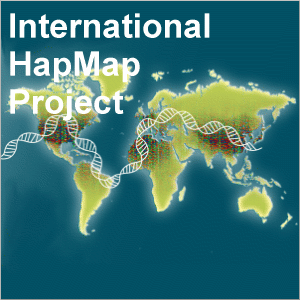International HapMap Consortium Releases All Data to the Public

The Consortium is developing a map (the ‘HapMap’) of the patterns of human genetic variation, called ‘haplotypes’, as a tool for researchers around the world to use in finding genes related to health and disease. Researchers in six countries – Japan, the United Kingdom, Canada, China, Nigeria, and the United States – have been working on this $130 million public-private project for the past two years, and expect to complete the HapMap by September 2005.
The basic data from the Project are genotypes – differences in the DNA sequence between individuals: the genotype data will be used to build the HapMap. All of the HapMap data have been submitted to the project’s Data Coordination Center (DCC) on a monthly basis, and the DCC sent information on assay designs for variation and frequencies of variations to the public databases – dbSNP and the Japanese SNP database – where they have been available to all researchers.
Using sophisticated computer programs, these raw data are assembled into haplotypes. To ensure all these important resources were kept in the public domain, the Consortium required researchers to agree (using just one click of a computer mouse) to the terms of a free, non-exclusive, non-royalty-bearing license to gain access to the individual genotype data from the HapMap project. Under this license, users only had to agree not to prevent others from using the data and to share the data only with those who had also agreed to this condition.
From its beginning, the consortium has made most of the results of the HapMap Project available to the scientific community and to the public quickly and freely on the Internet, in keeping with the data release approach established by the Human Genome Project.
The click-wrap license was designed as a temporary tool to continue the practice of providing rapid access to human genome data: its role was to ensure that this practice would continue. The consortium was concerned that other groups might combine some of the HapMap data on individual genotypes with their own data to generate patentable inventions on haplotypes and then use these patents to exclude researchers from being able to use the HapMap data, which some call ‘parasitic’ patents.
One consequence of the license requirement was that the temporary click-wrap license prevented HapMap data from being integrated into major public databases, which require that data deposited carry no conditions on use. There are now considerably more data and analysis methods than when the Consortium started. Consortium researchers have released data on about one million SNPs. In addition, Perlegen Sciences, Inc., of Mountain View, Calif., has publicly released genotype data on about 1.6 million SNPs. New methods have been developed to analyze the data and are being used to determine the haplotypes across the genome in the HapMap data. As a result of these advances, the consortium has concluded that the patterns of human genetic variation can readily be determined clearly enough from the primary genotype data to constitute prior art.
Thus, in the view of the consortium, derivation of haplotypes and ‘haplotype-tag SNPs’ from HapMap data should be considered obvious and thus not patentable. Therefore, the original reasons for imposing the requirement to obtain a license to see the data no longer exist, and the licensing requirement has been dropped by the HapMap consortium. The DCC and dbSNP will both show the monthly consortium data releases.
“We are excited that the HapMap data will be even more easily available for researchers to use to find genes that influence many common diseases, such as diabetes, hypertension and arthritis.”
Dr. Yusuke Nakamura Director of the University of Tokyo’s Human Genome Center and leader of the RIKEN SNP Center and the Japanese group working on the HapMap Project
“We are delighted that we will now be able to integrate the HapMap data with other genomic data. Researchers will now be able to study how this genetic variation information relates to genes and their function.”
Dr. Ewan Birney of the European Bioinformatics Institute Co-Head of Ensembl, one of the public databases that had been unable to incorporate the HapMap data
Researchers are already using the HapMap data to study conditions such as type 2 diabetes, asthma and dyslexia, as well as genes related to drug metabolism and adverse effects. The genome-wide HapMap is expected to be completed by September 2005, and to include about 4 million SNPs.
“Gene mappers have been using HapMap data as rapidly as we have been able to generate them. When the human haplotype map is complete, these studies will be able to be done even more efficiently than they have been until now. We are confident that the HapMap will facilitate the discovery of many genes that affect disease susceptibility or drug responsiveness.”
Dr. Francis S. Collins Director of the National Human Genome Research Institute at the National Institutes of Health, which leads the U.S. component of the International HapMap Project


